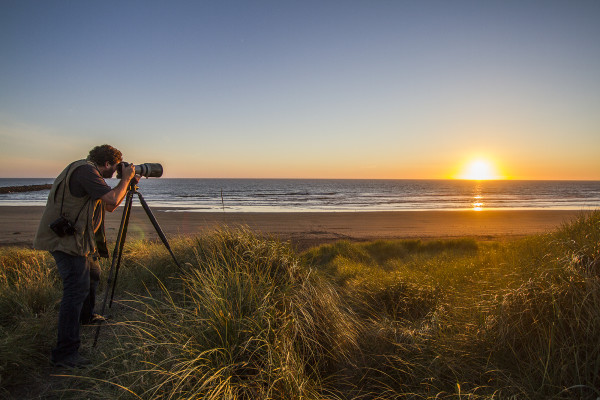Story by Kyle Mittan
Photos by Stuart May and Kyle Mittan
At 4 a.m. on April 4, 2015, Stuart May was still at work.
The Ocean Shores-based photographer had spent much of the night photographing the total lunar eclipse that had turned the night’s full moon entirely red as light from the sun shone through the Earth’s atmosphere. He came away with 30 shots he liked, later using 13 to make an array of the phases of the eclipse.

Kyle Mittan | The Daily World
Ocean Shores-based photographer Stuart May shoots photographs of the sunset off the coast in mid-June. May, who shot April’s lunar eclipse, says a sturdy tripod is key to successfully photographing the moon.
May owns Fusions Gallery along the beach town’s main drag. The Scottish (Glasgow-born) ex-patriot has been shooting nature and wildlife photography for 17 years and has owned the gallery for 13.
May has tens of thousands of dollars invested in camera gear and the shots he took that night can’t be achieved with a digital point-and-shoot or smartphone. But he says that most amateur photographers with today’s mid-range digital single-lens reflex cameras can take reasonably good photos of the eclipse, with the proper preparation.
When
The next lunar eclipse will occur in the early morning of Sept. 28. It will be the last of four, separated by about six-month stretches, a rarity that astronomers call a tetrad.
Total eclipses occur when the Earth passes between the moon and sun, casting a shadow across the entire moon, and not just a portion. The result is a moon that glows red until the Earth passes.
Expect to spend several hours shooting. May’s sequence followed the moon nearly until the eclipse had ended.
Where
May says the key to location is ensuring an unobstructed sky. Especially in a series of photos that tracks the moon’s movement through the sky, trees and buildings may ruin the shot.
“The front of your lens could move three feet over the course of several shots,” he said. “It’s especially important with a long lens, because long lenses (capture) very thin slices of the sky, so you’ve got to move it very frequently.”
Cloud coverage and light pollution are an issue, too. Weather forecasts starting about a week out are helpful, and areas far away from cities mitigate the glow of intrusive lights.
Coastal beaches are good, the more remote the better, including Ruby, Rialto, Shi Shi, First, Second and Third beaches and Lime Kiln Point. Inland, open, dark skies can be found in certain parts of Olympic National Park and Capitol State Forest.
What to bring
Aside from the camera, May says the most important piece of equipment for a night shoot is a sturdy tripod capable of holding relatively still in coastal winds. High-end tripods can cost hundreds, but mid-range models can be found for less than $100, then anchored in beach sand or weighted down with sand bags.
Although May shot April’s eclipse with a 400-millimeter lens, some 300-millimeter lenses can be bought brand new near the $200 mark, and capture the moon in relatively full detail. Crop sensor cameras, whose photos are zoomed-in as opposed to cameras with full-frame sensors, will also help the attached lens take a closer photo. Consult your camera’s user manual to find out which type of sensor it uses.
“Honestly, the better the camera you can afford, the better your results are going to be,” May says, but added that skills play a major part as well.
Another piece of equipment to consider includes a shutter release, which allows the photographer to take a photo with a remote connected to the camera by a cable. That reduces the shake caused by releasing the shutter with the button. Another remedy includes shooting in self-portrait mode, which will keep the camera from taking the shot for several seconds after pressing the shutter release.
As with most outings, May says to dress appropriately and remember that as night falls, things cool down in a hurry, especially along the coast. A winter coat and gloves might mean being able to stay out and shoot for a few more hours.
Taking the shots
Though shooting at night often requires long exposure, May says the moon is different.
“What people usually forget is that when you’re shooting the moon, you’re actually shooting the sunlight that’s reflecting off the moon,” he said.
To that end, photos of the moon can often be shot with a shutter speed of about 1/500 of a second or even faster. A more open aperture, which comes with a lower f-stop number, will also help to let in more light during the exposure.
May says one problem that comes with today’s digital cameras is “noise” — graininess that comes as a result of the sensor processing dark photos. The easiest way to combat this, he says, is to ensure the camera’s ISO is left at 100, or the lowest setting.
Post processing
For his series of 13 moon shots, May arranged them in Photoshop, with each image as a separate layer. Using the software’s guides, he set each moon an inch apart.
The only toning adjustments, May says, were to the moon’s contrast.
May says it’s easy to lose track of time shooting photos along the coast.
“You’ll be out here shooting and all of a sudden, it’s midnight,” he says. “It’s a great feeling.”
Kyle Mittan is the Aberdeen and Hoquiam reporter for The Daily World. An amateur photographer himself, now he knows how he’ll spend the night of Sept. 27. Contact him at 360-537-3932 or kmittan@thedailyworld.com. Find him on Twitter @KyleMittan.